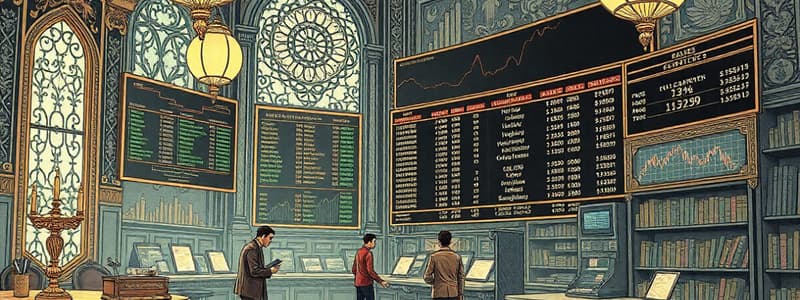Podcast
Questions and Answers
What is defined as the highest buying price and the lowest selling price in trading operations?
What is defined as the highest buying price and the lowest selling price in trading operations?
- Board Lot
- Best Bid and Offer (BBO) (correct)
- Reference Price
- Trading Threshold
What does the term 'Static Threshold' refer to in trading?
What does the term 'Static Threshold' refer to in trading?
- The permitted price update between trades
- The volume of shares traded in an odd lot
- The allowable price limits for a security in a trading day (correct)
- The highest price a stock can reach in a trading day
What can trigger a cooling-off period in trading?
What can trigger a cooling-off period in trading?
- A stock reaching its Static Threshold
- The last traded price exceeding the Dynamic Threshold (correct)
- Achieving the trading volume of the board lot
- A stock closing at its Reference Price
What is the accepted increment for price movement if the tick size is $0.01?
What is the accepted increment for price movement if the tick size is $0.01?
Which scenario would constitute a Trading Day?
Which scenario would constitute a Trading Day?
What is the maximum quantity of shares that can be disclosed at any given time if the total order quantity is 10,000 shares?
What is the maximum quantity of shares that can be disclosed at any given time if the total order quantity is 10,000 shares?
Which account type is defined as orders for various clients that are grouped together, such as funds?
Which account type is defined as orders for various clients that are grouped together, such as funds?
What happens if a foreign investor attempts to place an order that exceeds the foreign ownership limit?
What happens if a foreign investor attempts to place an order that exceeds the foreign ownership limit?
Which statement regarding account code amendments is correct?
Which statement regarding account code amendments is correct?
What is the fee charged for amending account codes?
What is the fee charged for amending account codes?
Which type of order is defined as having a volume less than the board lot or minimum shares requirement?
Which type of order is defined as having a volume less than the board lot or minimum shares requirement?
What characterizes a related party account type in trading?
What characterizes a related party account type in trading?
What is the Dynamic Threshold (DT) percentage for securities that have traded more than 500 times in the past six months?
What is the Dynamic Threshold (DT) percentage for securities that have traded more than 500 times in the past six months?
Which type of trading involves transactions agreed upon between parties for larger lots?
Which type of trading involves transactions agreed upon between parties for larger lots?
In cross transactions, which of the following conditions must be met regarding pricing?
In cross transactions, which of the following conditions must be met regarding pricing?
What type of trading is characterized by trading shares less than the defined board lot?
What type of trading is characterized by trading shares less than the defined board lot?
What is the latest time Level 1 Circuit Breaker (CB) can be triggered?
What is the latest time Level 1 Circuit Breaker (CB) can be triggered?
During the PRE-CLOSE period at 2:45 PM, which of the following is true?
During the PRE-CLOSE period at 2:45 PM, which of the following is true?
During which period can cross transactions not be entered?
During which period can cross transactions not be entered?
What activity is restricted during the PRE-CLOSE at 2:48 PM?
What activity is restricted during the PRE-CLOSE at 2:48 PM?
For a security that traded 20 times or less in the past six months, what is its corresponding Dynamic Threshold percentage?
For a security that traded 20 times or less in the past six months, what is its corresponding Dynamic Threshold percentage?
What is the main feature of the Normal Market?
What is the main feature of the Normal Market?
What happens during the CLOSING RUN-OFF?
What happens during the CLOSING RUN-OFF?
What is a key objective of the Risk Based Capital Adequacy Ratio (RBCA) rules?
What is a key objective of the Risk Based Capital Adequacy Ratio (RBCA) rules?
What occurs during an Automatic Cross?
What occurs during an Automatic Cross?
Which option is NOT a characteristic of Block Sales?
Which option is NOT a characteristic of Block Sales?
Which of the following best describes the Minimum level of capital required for Trading Participants (TP)?
Which of the following best describes the Minimum level of capital required for Trading Participants (TP)?
At what time does the market officially close?
At what time does the market officially close?
What is NOT allowed during the PRE-CLOSE period at 2:48 PM?
What is NOT allowed during the PRE-CLOSE period at 2:48 PM?
Which of the following describes the Automated Cross feature?
Which of the following describes the Automated Cross feature?
Flashcards
Best Bid and Offer (BBO)
Best Bid and Offer (BBO)
The highest buying price (bid) and the lowest selling price (offer) for a security.
Trading Threshold
Trading Threshold
The permitted price range for a security on a given trading day.
Static Threshold (Trading Band)
Static Threshold (Trading Band)
The upper and lower price limits (ceiling and floor) for a security on a trading day.
Board Lot
Board Lot
Signup and view all the flashcards
Price Fluctuation (Tick Size)
Price Fluctuation (Tick Size)
Signup and view all the flashcards
Disclosed Quantity
Disclosed Quantity
Signup and view all the flashcards
Total Order Quantity
Total Order Quantity
Signup and view all the flashcards
Oddlot Order
Oddlot Order
Signup and view all the flashcards
Account Code
Account Code
Signup and view all the flashcards
Principal Account
Principal Account
Signup and view all the flashcards
Related Party Account
Related Party Account
Signup and view all the flashcards
Foreign Ownership Limit
Foreign Ownership Limit
Signup and view all the flashcards
Order Queuing
Order Queuing
Signup and view all the flashcards
Matching
Matching
Signup and view all the flashcards
Odd Lots
Odd Lots
Signup and view all the flashcards
Cross Transactions
Cross Transactions
Signup and view all the flashcards
Automatic Cross
Automatic Cross
Signup and view all the flashcards
Block Sales
Block Sales
Signup and view all the flashcards
Level 1 Circuit Breaker
Level 1 Circuit Breaker
Signup and view all the flashcards
Level 2 Circuit Breaker
Level 2 Circuit Breaker
Signup and view all the flashcards
Level 3 Circuit Breaker
Level 3 Circuit Breaker
Signup and view all the flashcards
Dynamic Threshold
Dynamic Threshold
Signup and view all the flashcards
Trading Frequency Qualifier
Trading Frequency Qualifier
Signup and view all the flashcards
What are the three trading frequency categories and their corresponding Dynamic Thresholds?
What are the three trading frequency categories and their corresponding Dynamic Thresholds?
Signup and view all the flashcards
Normal Market
Normal Market
Signup and view all the flashcards
Oddlot Trading
Oddlot Trading
Signup and view all the flashcards
What are the requirements for a Cross Transaction?
What are the requirements for a Cross Transaction?
Signup and view all the flashcards
Study Notes
Philippine Stock Exchange (PSE) Trading Rules
- Trading Operations: Trading operations follow specific rules and procedures
- Definition of Terms: Concepts like Best Bid and Offer (BBO), Reference Price, Trading Thresholds (Static and Dynamic), Board Lot, Price Fluctuation (Tick Size), and Odd Lot are defined.
- Trading Schedule: Trading days exclude Saturdays, Sundays, legal holidays and other declared non-trading days. Specific trading hours are defined (Pre-Open, Open, Continuous Trading, Market Recess, Pre-Close, Closing, Run-Off/Trading at Last).
- Order Types: Different order types exist, including Limit Orders (specifying maximum buy/minimum sell price) and Minimum Quantity Orders (requiring a specific minimum quantity to be filled immediately).
- Iceberg (Disclosed) Orders: This allows large orders to be entered into the Central Order Book gradually(dividing into smaller lots).
- By Lot Size: Trading occurs in board lots or odd lots.
- By Account Type: Account codes categorize investors (Principal, Retail, Institutional, Tax-exempt, Aggregate, Related Party, Error, Local, Foreign).
- Foreign Ownership Limit: Limits on foreign ownership of certain securities exists in the trading system
- Trade Amendment: Procedures exist for amending account codes, while specific restrictions apply to foreign and local account codes.
- Aggregation of Client Orders: Rules cover aggregating client orders while ensuring compliance with specific rules.
- Done-Through Transaction: Transactions are executed at a price outside the market spread by one TP using another TP
- Trading Thresholds: Static and Dynamic Thresholds (trading band) limits the range in which a security can be traded
- Block Sales: Large-volume transactions are negotiated separately.
- Automatic Cross Transactions: Rules govern trades executed automatically when matching orders at similar prices occur, ensuring precedence.
- Odd Lots: Trading of shares less than a board lot is allowed.
- Order Modification: Modifications of orders after certain times are not permitted
- Order Cancellation: Cancellations are not allowed during specific trading durations (Pre-Open, Pre-Close and Last 2 minutes before closing)
- Circuit Breaker: Levels one, two and three of the circuit breaker are defined; when triggers are met, trading is halted for different durations.
- Trade Cancellation: The Exchange may not cancel matched or executed orders. Exceptions may apply, primarily due to evidence of mistake or computer/system error
- Block Sale Rules: Rules and forms exist for special large block sales in the stock market.
- Trading Halt: Rules exist for events like trading halting of certain securities.
Risk-Based Capital Adequacy Ratio (RBCA)
- Regulations ensure that companies are sufficiently capitalized to cover their financial obligations
- RBCA Rules: Minimum capital is based on the size and complexity of operations, considering different business risks.
- Reportorial Requirements: Specific reporting requirements(e.g., bi-monthly submission of RBCA reports, with dates for submission); are required in relation to covering periods.
- RBCA Formula (NLC) calculations are important in assessing the solvency and financial strength of financial institutions.
Studying That Suits You
Use AI to generate personalized quizzes and flashcards to suit your learning preferences.



